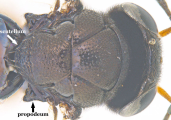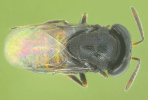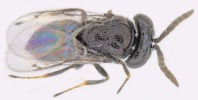Scientific name
Cephaleta australiensis (Howard)
Taxonomic position
Hymenoptera: Chalcidoidea: Pteromalidae: Eunotinae
Diagnosis
Head, mesosoma and metasoma shiny metallic black, antenna brown except scape and apical segment of club darker brown, legs yellowish brown except all coxae black, tarsi dark brown, first pair of legs slightly darker brown. Head much wider than mesosoma, vertex sharply angulate behind ocelli, posterior ocellus touching hind margin of vertex; gena strongly shiny between hairs, posteriorly bound by a distinct, fine carina. Antennal formula 11143 in female; male antenna nine-segmented, with all funicular segments longer than broad, first one curved and longer than scape. Thorax / mesosoma shiny
between hairs which are placed on papillae. Notaular lines complete. Scutellum with silvery white hairs in apical third, apically slightly produced over propodeum. Hind corner of propodeum forming a sharp straight vertical edge with an angular tooth dorsally. Fore wing pilose.

 Images


 Adult, dorsal view Adult, dorsal view

 Adult, lateral view Adult, lateral view
Distribution
Widely distributed throughout India (Andaman and Nicobar Islands, Andhra Pradesh, Bihar, Delhi, Kerala, Tamil Nadu, Karnataka, Uttar Pradesh, West Bengal). Oriental region. Nearctic.
Hosts / Biology
Commonly collected in association with several species of Coccoidea (Sternorrhyncha) including Coccus spp., Ceroplastes spp., Saissetia spp., Drepanococcus chiton, Pulvinaria psidii (Coccidae); Cerococcus indicus (Cerococcidae); Ferrisia virgata (Pseudococcidae); and Asterolecaniidae.
References
- Xiao, H. & Huang, D.W. 2001. A review of Eunotinae (Hymenoptera: Chalcidoidea: Pteromalidae) from China. Journal of Natural History, 35: 1587-1605.
- Narendran, T.C. & Mini, T.V. 2000. A review of the genera of Oriental Eunotinae (Hymenoptera: Pteromalidae). Journal of the Zoological Society of Kerala, 8&9: 15-28.
|